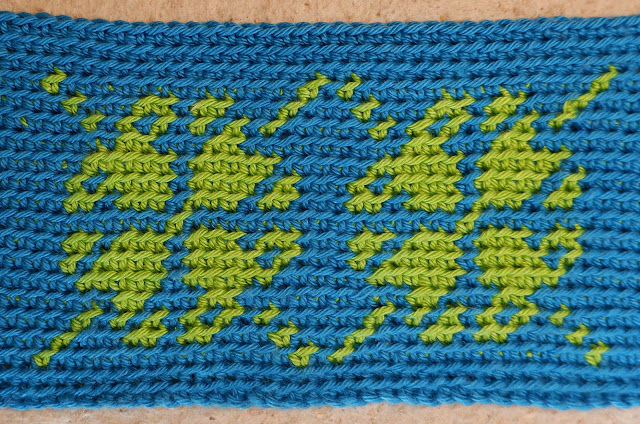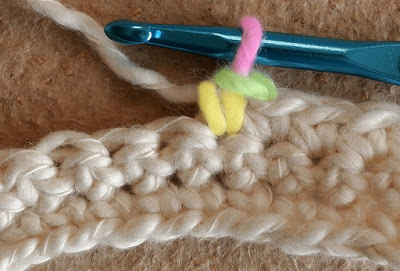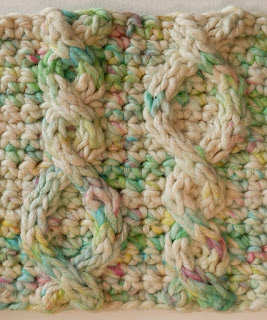Last month I looked at how to make Tapestry crochet in the round and how to stop the pattern from creeping towards the right. Wouldn't it be so much easier to work in turned rows? Well, of course! But, the fabric has to be made from the front only; or so I thought!
Some crocheters do in fact make this crochet in rows, but as you know working Dc(UK, Sc-US) in turned rows creates a different look to working in the round. It makes the design messy and indistinct.
Working to and fro in Dc is sometimes called Rose stitch. In this sample I have worked half into back loop only and half in both loops.
The solution was given to me by Anna (aka Mmatildas Virstad). Forward facing rows are made as standard, but reverse facing rows are made with inverse stitches. These are also known as Purl stitches.
Insert the hook into the next stitch from back to front,Yarn-Under (or Yarn-Over) the hook and pull up a loop, (this makes the post)
Yarn-Under (or Yarn-Over) the hook and pull through both loops on the hook. (this makes the top loop)
I have seen both yarn-over (YO) and yarn-under (YU) used to make an inverse stitch. As I discovered last month, it does make a difference! So which should we do?
Working in the round, I discovered that, working in the back-loop-only and making a YU to pull up the first loop and make the post creates a little X rather than a V shape. But the YU that finishes the stitch made the stitches stack neatly on top of each other. Is the same thing true when working in rows?
For my first sample I worked the odd numbered rows as standard. For the even rows, the inverse stitches are made with Yarn-under.
As a result for the standard Dc the tops of the stitches lean down to the left, but on the inverse stitches they lean to the right. This makes the columns of stitches zigzag. The Yarn-under also makes the post of each stitch look different. They lean more to the right and look more like an X than a V.
Now I have made all the stitches with only Yarn-over. The only difference is that the posts of the Dc and inverse Dc look more similar. But the columns still zigzag.
I wondered if it would make a difference if I made a Yarn-under for the top loop of the standard Dc only. It seems to make no difference at all!
If I was being truly scientific there are many variations I should try, but for thoroughness I felt that I aught to try to Yarn-under only on both rows. While the posts of the stitches look very similar, they are now like mirror images. The Dc slope to the right, while the inverse Dc slope to the left.
I have concluded that the best result is achieved by Yarn-overs on both rows. This is how it looks when made through both loops. I find it rather messy. It looks much better when made in Back-loop only.
Sometimes Waistcoat stitch is used. I used the inverse Dc stitches on the odd numbered rows. The difference is that the Dc is made into the centre of the stitch below. The V's of the post stitches appear to stack one on another. I have never made this stitch before. The overall look is better, the columns are straighter. But, the fabric is thicker and the swatch is shorter.
To make a comparison with my very first swatch, I have remade it with the Inverse Yarn-over stitches on the even numbered rows. The fabric is taller, thinner and softer and the design is clearer.
I would be remiss if I did not remind you that an alternative is to work from right to left only. Don't forget to Yarn-under for the top loops and work in back-loop only to create the straight columns. For this sample I began and ended each row with a slip stitch, catching in the second colour. Either you can leave the ends as tassels or catch them in with some kind of binding or edging stitches.
I think I have done enough experimenting for a while. It's almost as boring to read about as it is to do! But these purl stitches are a useful stitch to have in our crochet toolbox. There are other ways to create Tapestry crochet which I am still discovering and being surprised by. You'll find them on Anna's blog!
Next month I think we should learn something new!
























































